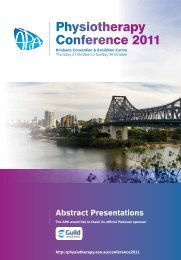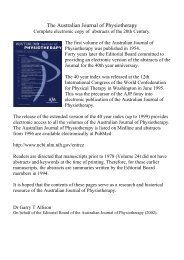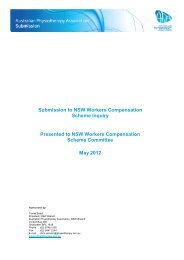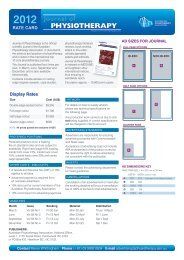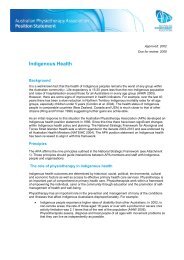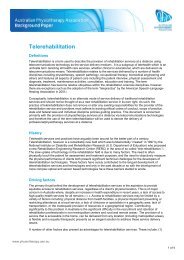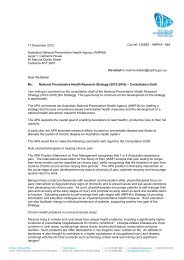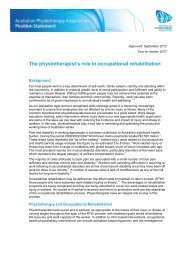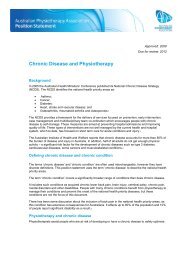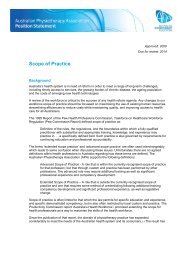The Australian Journal of Physiotherapy
The Australian Journal of Physiotherapy
The Australian Journal of Physiotherapy
You also want an ePaper? Increase the reach of your titles
YUMPU automatically turns print PDFs into web optimized ePapers that Google loves.
Volume 5. 1959<br />
Burnell AW (1959): Why physical medicine? <strong>Australian</strong> <strong>Journal</strong> <strong>of</strong> <strong>Physiotherapy</strong> 5: 5-9.<br />
This paper reviews the current situation <strong>of</strong> physical medicine in Australia compared with that <strong>of</strong><br />
overseas nations, and discusses the effects <strong>of</strong> its presence on physiotherapy. <strong>The</strong> functions <strong>of</strong> the<br />
specialist in physical medicine are described, and include the provision <strong>of</strong> an accurate diagnosis and<br />
plan <strong>of</strong> treatment, the improvement <strong>of</strong> the status <strong>of</strong> physiotherapy and integration <strong>of</strong> the<br />
rehabilitation team. <strong>The</strong> author describes the operation <strong>of</strong> a physical medicine department in<br />
England, and the role <strong>of</strong> the physiotherapist within this structure. It is concluded that a physical<br />
medicine department has more to <strong>of</strong>fer than a physiotherapy department.<br />
Keywords: Consultant; Physical Medicine; Physical <strong>The</strong>rapy; Rehabilitation Centres<br />
Hobson EPG (1959): Recent trends in physiotherapy in the United Kingdom. <strong>Australian</strong> <strong>Journal</strong> <strong>of</strong><br />
<strong>Physiotherapy</strong> 5: 10-13.<br />
An impression <strong>of</strong> the current status <strong>of</strong> physiotherapy in the United Kingdom is presented by the<br />
Superintendent Physical <strong>The</strong>rapist at King's College Hospital, London. A description is given <strong>of</strong> the<br />
impact <strong>of</strong> new therapeutic methods in physiotherapy, and the functioning <strong>of</strong> the physiotherapy<br />
department under the direction <strong>of</strong> a consultant in physical medicine. Also discussed are the new<br />
trends in remedial exercises, team work in management, and resettlement clinics held at the<br />
hospital. <strong>The</strong> author concludes by emphasising the need for physiotherapy to keep pace with the<br />
present needs <strong>of</strong> society.<br />
Keywords: Consultant; Physical Medicine; Physical <strong>The</strong>rapy; Physical <strong>The</strong>rapy Department,<br />
hospital;<br />
Maitland GD (1959): <strong>The</strong> treatment <strong>of</strong> lesions in the cervical region by manipulation.<br />
<strong>Australian</strong> <strong>Journal</strong> <strong>of</strong> <strong>Physiotherapy</strong> 5: 41-46.<br />
Relevant points in the history and examination <strong>of</strong> a patient with a suspected lesion <strong>of</strong> the cervical<br />
spine are discussed. Both direct and indirect techniques <strong>of</strong> manipulation in this region and their<br />
indications are described. <strong>The</strong> treatment approach is illustrated through the presentation <strong>of</strong> four case<br />
histories.<br />
Keywords: Cervical Vertebrae; Manipulative <strong>The</strong>rapy; Neck; Physical <strong>The</strong>rapy;<br />
Paige MJ (1959): Manipulation in the management <strong>of</strong> the first lumbar root syndrome.<br />
<strong>Australian</strong> <strong>Journal</strong> <strong>of</strong> <strong>Physiotherapy</strong> 5: 47-50.<br />
<strong>The</strong> anatomy <strong>of</strong> the first lumbar nerve is reviewed and a symptomatic classification <strong>of</strong> 41 patients<br />
with pain related to this nerve with four categories is outlined. <strong>The</strong> results <strong>of</strong> treatment by<br />
manipulation are good in most instances, but are less satisfactory when the pain begins or is<br />
aggravated during some particular phase <strong>of</strong> the menstrual cycle. A case history is presented for each<br />
<strong>of</strong> the classification groups to illustrate the presenting features, manipulative management and<br />
assessment <strong>of</strong> response.<br />
Keywords: Low Back Pain; Manipulative <strong>The</strong>rapy; Neuralgia; Physical <strong>The</strong>rapy<br />
Fisher A (1959): Facial palsy. <strong>Australian</strong> <strong>Journal</strong> <strong>of</strong> <strong>Physiotherapy</strong> 5: 50-52.



